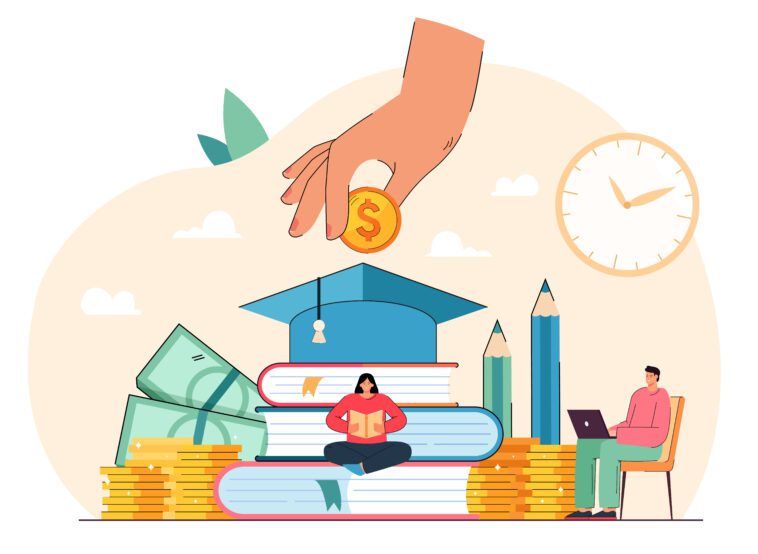Student loans can be an invaluable resource to help cover education-related costs, from paying for community college to university or graduate school tuition and purchasing supplies. Whatever the educational endeavor, a student loan is an invaluable way to finance it.
Before taking out a student loan, it’s essential to comprehend its workings. By understanding the various types of student loans and their interest rates and repayment options available to you, you can make an informed decision that best meets your individual needs.
Interest Rates
Interest rates, whether you’re searching for federal student loans or private ones, should always be taken into account when making your decision. They can range anywhere from 4.45% for federal student loans (in 2018) to 11-15% for private student loans and can add up quickly over time.
Generally, the lender sets the interest rate for a loan. In certain cases, this can also be determined by the borrower’s credit history or even the purpose of the loan (such as parent student loan or consolidation loan).
Federal student loans usually have fixed interest rates, while private student loans vary based on your credit rating. Borrowers with higher credit scores usually qualify for lower rates while those with lower scores often face higher costs.
Federal student loan interest rates are determined by benchmark interest rates such as the 10-year Treasury bond rate or LIBOR (London Interbank Offered Rate). These rates reflect larger economic forces and market prices.
Many private lenders use a more general benchmark interest rate, such as the prime rate or 3-Month CME Term SOFR index. These rates reflect the general economy and may provide an accurate indication of future changes to interest rates.
Interest rates typically decrease when borrowers meet certain criteria, such as enrolling in automatic payment plans, making timely payments, or getting a cosigner release. Furthermore, some lenders provide relationship discounts if you already have an active checking account with them.
When searching for student loans, it’s wise to compare rates from multiple lenders and find the lowest possible one that meets your educational requirements. Doing this will enable you to get the most competitive rate possible.
Federal student loans offer fixed interest rates, while private student loans depend on your credit score and income. Without a high credit score or substantial amounts to borrow, private student loans may be more costly than federal ones. On the other hand, they come with various advantages like flexible repayment plans and debt consolidation opportunities.
Repayment Options
Federal student loans offer various repayment plans, and the one best suited to you depends on your financial situation. By choosing the appropriate plan, you can better manage your debt and save money in the long run.
The Standard Repayment Plan is the most common federal loan repayment option, which spreads out equal payments over your entire loan term. While this option will save you the most interest over its course, it may take longer to pay off all of your loans.
Another popular option is the Graduated Repayment Plan, which starts with low payments but increases them every two years. While this may be a more manageable method of making payments, it may prove challenging for borrowers to stay current with their monthly obligations.
Selecting a repayment plan is crucial, as it impacts your budget and how much interest you pay over the life of your loan. Generally, opt for one that offers both affordability and convenience.
If you can’t afford your current payments, consider an income-driven repayment plan that ties payments to family size and discretionary income. If applicable, this could reduce your payments and even lead to loan forgiveness in some cases.
This type of plan also allows for prepayment of your loans, which can be an excellent way to reduce overall interest costs and save money in the long run. Before making a decision like this, make sure you consult with your loan servicer for specifics.
There are various student loan repayment options that you can utilize to temporarily postpone or restructure your payments for a shorter timeframe. These include deferment, forbearance and income-driven repayment.
These options can provide temporary financial assistance during times of hardship, such as job loss or a medical emergency. Unfortunately, these aren’t permanent solutions and the interest that accrues during these periods will be added to your principal balance when repayment resumes.
You can use the government’s Loan Simulator tool to assess your situation and find a solution that makes sense for you. Spending just a few minutes exploring your options can give you peace of mind and prevent financial disaster in later life.
Entrance Counseling
Student loan entrance counseling is a mandatory requirement for all first-time federal borrowers. It explains your rights and responsibilities as a borrower, as well as providing crucial information about your loans such as interest rates, repayment options, and potential repercussions of defaulting.
Entrance counseling is free and takes around 20 to 30 minutes. It’s an ideal opportunity to become familiar with your student loans and how they operate, as well as gain insight into personal finances and budgeting.
To learn more about entrance counseling, you can check the website of your school’s financial aid office for instructions on how to complete it. This session will give you advice for managing debt responsibly so that late fees and default are avoided.
Making the time to complete this course can make all the difference in your long-term financial security and college success. Counseling is offered by many companies, including student loan servicers themselves.
Additionally, schools may require students to attend additional entrance counseling at their host institution as part of their financial aid package. This is especially true for new borrowers or those with higher loan amounts.
Entrance counseling is mandatory for all new first-time borrowers and it’s recommended that they complete it prior to receiving their initial loan disbursement. It’s especially crucial to attend this initial session since it will provide you with important insights into loan terms and responsibilities before any funds are released.
If you need more information about student loans, there are plenty of resources that can help. From the Department of Education website to nonprofit organizations providing financial wellness services and debt management assistance, if you’re uncertain of your rights or responsibilities as a borrower, speak with the financial aid office at your school or contact the student loan company directly for clarification.
In addition to entrance and exit counseling, students with federal student loans must complete a Master Promissory Note (MPN). This legal document guarantees your repayment of the loan(s), plus any accrued interest and fees. There is one MPN for Direct Subsidized and Unsubsidized Loans, while Direct PLUS Loans require another MPN.
Disbursements
Student loans are debt instruments issued by either the federal government or private lenders to assist borrowers in financing their education. They can be used for tuition, books and other school-related costs.
Your loan amount is determined by your academic year, loan type and whether or not you are an undergraduate or graduate student. Furthermore, you must have a good credit history and qualify with a qualified cosigner in order to secure this loan.
Interest rates on federal loans are set by Congress and determined based on the cost of borrowing on the bond market. Private loan interest rates are negotiated between you and your lender.
If you want to reduce your student loan balance, refinancing may be the answer. Unfortunately, this may not result in as substantial a reduction of monthly payments as anticipated.
Another option is to look into income-driven repayment plans or making extra payments to reduce your overall loan balance. Some employers provide these programs, such as Aetna, PwC and Google.
Other solutions include budgeting, which helps identify areas where you can cut back and lower expenses. Furthermore, you may qualify for student loan forgiveness or other forms of student debt assistance.
According to a recent report from Employee Benefit Research Institute, more than 15% of employers provide some form of student loan assistance program. These can include matching programs that help motivate employees to pay down their debt.
Students often discover it easier to pay off their student loans when they have an additional source of funds available for repayment. This can be an effective strategy for paying off debt more quickly and saving money in the long run.
When receiving a refund, it’s essential to use it wisely and only request when absolutely necessary. For instance, medical bills might come due or you might have a new baby on the way; or perhaps you’re moving for work purposes.
Regular payments are important to stay out of default and boost your credit score. If you’re having difficulty, reach out to your lender or a consumer advocacy organization for assistance.



